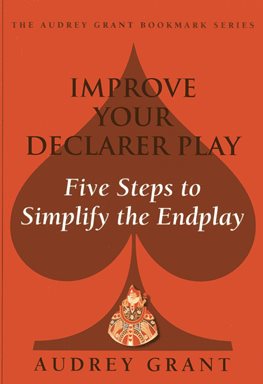Source: ABF newsletter; Sept 2014 by Joan Butts ![]()
![]()
![]()
![]()

The idea that, even in the face of bad luck, there is a way to make the contract, has fascinated bridge players for decades. Here’s where the endplay takes centre stage. By following five easy steps, you’ll be able to set up an endplay and make contracts you never thought you could. It’s all in the way you think about a hand, and sometimes it’s best to let the opponents do your work for you. So…the basic idea behind the endplay is straightforward. There are some suit combinations where it is better to have the suit led by a defender into the declarer’s strength.
Take this hand:
Contract: 6![]() by South, West leads
by South, West leads ![]() Q.
Q.
There are five steps declarer uses to set up an endplay:
1. Consider the objective; count the winners in a no trumps contract and the losers in a suit contract; determine how many extra tricks are needed, or how many losers need to be eliminated. In the 6![]() contract, declarer can afford one loser. Declarer has two potential losers: a heart and a diamond. Declarer has to get rid of one loser to make the contract. The best chance appears to be the heart finesse, hoping East holds
contract, declarer can afford one loser. Declarer has two potential losers: a heart and a diamond. Declarer has to get rid of one loser to make the contract. The best chance appears to be the heart finesse, hoping East holds ![]() K. That’s a 50% chance, but it doesn’t work on the actual deal. Is there anything declarer can do to improve the odds?
K. That’s a 50% chance, but it doesn’t work on the actual deal. Is there anything declarer can do to improve the odds?
2. Recognise a suit better led by a defender. If declarer can get West to lead a heart, the contract would become 100% secure. Declarer can apply the technique of the endplay to bring this about.
3. Identify the exit card to put a defender on lead. Declarer has to identify a card that can be played at the right time to put West on lead. ![]() 9 is the exit on the third round of diamonds. The opening lead is
9 is the exit on the third round of diamonds. The opening lead is ![]() Q. Declarer also expects West has
Q. Declarer also expects West has ![]() J and maybe
J and maybe ![]() 10, and may have to win the third diamond trick.
10, and may have to win the third diamond trick.
4. Eliminate the defender’s other options: The basic idea is to eliminate West’s other options and then throw-in West at the appropriate time, when West has no choice but to lead a heart. Declarer starts by winning the fi rst diamond trick and drawing the defenders’ trumps. Since West has all three, this takes three rounds. Declarer then takes the three club winners, and then the diamond winners, leaving the following cards: 5. Put a defender on lead with the exit card. Declarer leads the last diamond. This is the exit card – the card that puts the defenders on lead. Now West is on lead with
5. Put a defender on lead with the exit card. Declarer leads the last diamond. This is the exit card – the card that puts the defenders on lead. Now West is on lead with ![]() J, and West has no choice but to lead a heart, right into declarer’s
J, and West has no choice but to lead a heart, right into declarer’s ![]() AQ. Declarer makes the contract, and the heart finesse was not on. Some suit combinations require a specific defender to be on lead. In others, if doesn’t matter which defender is on lead. Declarer can’t always control this, and may have to fall back on other options.
AQ. Declarer makes the contract, and the heart finesse was not on. Some suit combinations require a specific defender to be on lead. In others, if doesn’t matter which defender is on lead. Declarer can’t always control this, and may have to fall back on other options.
This material is from “Improve Your Declarer Play: Five Steps to Simplify the End Play” by Audrey Grant.
